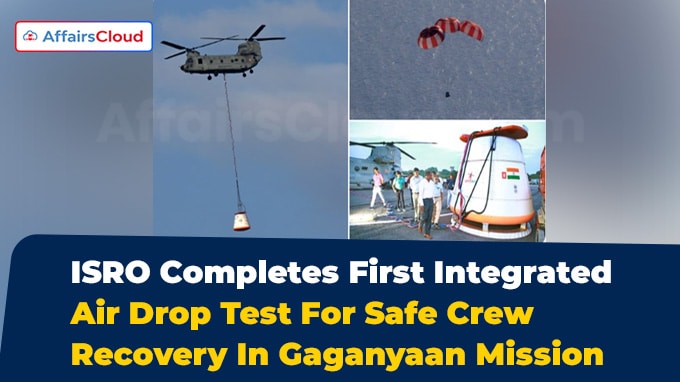 On August 24, 2025, Indian Space Research Organization (ISRO), Department of Space (DoS), successfully conducted its first Integrated Air Drop Test (IADT-1) of the Crew Module Recovery System as part of India’s first human spaceflight programme ‘Gaganyaan Mission’, at Satish Dhawan Space Centre (SDSC), Sriharikota, Andhra Pradesh(AP).
On August 24, 2025, Indian Space Research Organization (ISRO), Department of Space (DoS), successfully conducted its first Integrated Air Drop Test (IADT-1) of the Crew Module Recovery System as part of India’s first human spaceflight programme ‘Gaganyaan Mission’, at Satish Dhawan Space Centre (SDSC), Sriharikota, Andhra Pradesh(AP).
- IADT-1 was carried out to evaluate the parachute deployment sequence and capability of safe landing by the Crew Module during the re-entry and recovery operations.
Exam Hints:
- What? Conducted first Integrated Air Drop Test (IADT-1)
- Who? ISRO
- Collaborator: IAF, DRDO, IN, and ICG.
- Purpose: To ensure the reliability of the Parachute System
- Weight: 5 tonnes
- Air Drop: Lifted & dropped from IAF CH-47F(I) Chinook helicopter
- Parachute: Apex Cover Separation (ACS), Drogue, Pilot, Main Parachutes
About Integrated Air Drop Test (IADT):
Collaboration: The demonstration was carried out in coordination with the ISRO, the Indian Air Force (IAF), the Defence Research and Development Organisation (DRDO), the Indian Navy (IN), and the Indian Coast Guard (ICG).
Test Duration & Location: The drop was conducted over the Bay of Bengal and lasted nearly an hour from take-off to recovery.
Parachute Configuration: It comprised four types of parachutes : Apex Cover Separation (ACS) (2 units), Drogue (2 units), Pilot (3 units), and Main Parachutes (3 units).
Air drop: During the trial, a dummy version of the capsule, weighing 5 tonnes, was lifted and air dropped by the IAF Chinook helicopter(CH-47F(I) Chinook) at an altitude of approximately 3 kilometre(km), simulating the conditions re-entry when it descends through the atmosphere.
Parachute Deployment Sequence: The parachute system is designed in a sequence, beginning with two drogue parachutes for initial stabilization and deceleration, followed by pilot chutes and three main parachutes to enable controlled descent and ensure a safe landing.
Main Parachutes: During the mission, the main parachutes cannot deploy at very high speeds. It will have to deploy immediately after the heat shield and drogue parachutes slow down the speed, ensuring the safe landing of the astronauts.
About Gaganyaan Mission:
Overview: Gaganyaan Mission, led by the ISRO, will send 3-member Indian crew into Low Earth Orbit (LEO). The crew will travel at an altitude of 400 (km) for a three-day expedition and ensure safe re-entry and recovery in the Indian Ocean.
Aim: The mission aims to develop the indigenous capabilities in human-related launch systems, life-support systems, crew escape mechanisms, and recovery operations.
Launch Vehicle: The Human-Rated Launch Vehicle Mark-3 (HLVM-3) is the launch vehicle of the Gaganyaan Mission.
About Indian Space Research Organization (ISRO):
Chairman – Dr. V. Narayanan
Headquarters – Bengaluru, Karnataka
Established – 1969




